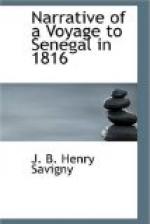The Island of Teneriffe is not equal to that of Madeira: one cannot even compare their agricultural productions, on account of the great difference of their soils: but in a commercial view, Teneriffe has the advantage of Madeira. Its geographical position in the middle of the Canaries, enables it to carry on an extensive trade, while Madeira is confined to the sale and exchange of its wines for articles of European manufacture.
The soil of Teneriffe is much drier; a great part of it is too volcanic to be used for agriculture: every part of it however, which is capable of producing anything is very well cultivated, which should seem to prove, that the Spaniards of this country are naturally much less indolent than they have been represented.[A3]
When we were in the open sea we had favorable winds from the N.N.E.
In the night of the 29th of June the frigate caught fire between decks, by the negligence of the master baker; but being discovered in time, the fire was extinguished. In the following night the same accident was repeated; but this time it was necessary, in order to stop the progress of the fire, to pull down the oven which was rebuilt the next day.
On the 1st of July we descried Cape Bayados, situated in latitude 26 deg. 12’ 30”, and in longitude 16 deg. 47’. We then saw the skirts of the immense desert of Zaara, and we thought we perceived the mouth of the river St. John [A4], which is very little known. We passed the tropic at ten o’clock in the morning; the usual ceremony was there performed with a certain pomp; the jokes of the sailors amused us for some moments; we were far from thinking of the cruel event which was soon to deprive of their lives a third of the persons who were on board the frigate. This custom of tropical baptism is strange enough; the chief object of it, is, to procure the sailors some money.
From St. Croix, we had constantly steered to the S.S.W. During the ceremony at the tropic we doubled Cape Barbas, situated in lat. 22 deg. 6’, and long. 19 deg. 8’: two officers suddenly had the course changed, without informing the captain; this led to a pretty warm dispute, which however had no serious consequences. These two officers affirmed that we were running upon a group of rocks, and that we were already very near to the breakers. We had sailed the whole morning in the Gulph of St. Cyprian, the bottom of which is strewed with rocks, so that at low water, brigantines cannot frequent these seas, as we were told at Senegal by M. Valentin, senior, who is perfectly acquainted with this whole coast, and could not conceive how the frigate could have passed amidst all these reefs without striking. The shore was within half a cannon shot, and we clearly saw enormous rocks over which the sea broke violently.[11] If it had fallen calm, there is no doubt but the strong currents which set, in-shore, would have infallibly carried us into danger.




